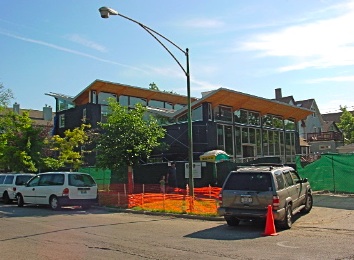
Image Credit: Farr Associates
For those who have the financial resources to do it, building a deep green house can become an enormous enterprise.
Chicago resident Michael Yannell seemed to have embraced that prospect shortly after he acquired a 1908 farmhouse a few years ago and an inspection revealed that the best course of action would be to deconstruct, salvage, and recycle rather than remodel. Yannell then began a quest to build a net-zero energy house that would honor virtually every known green construction, design, and land-use precept, top the LEED for Homes ratings, and become one of the best-known showcases for green living in Chicago, if not the country.
It’ll be a little while longer before we know whether the four-bedroom, two-bath house, which is divided into two buildings and cost about $1.6 million to build, earns a LEED Platinum rating, and it will take several months longer to determine whether it can perform to net-zero standards.
But Yannell’s full green immersion may be, at the very least, one of the best-documented in recent memory. His team of architects, engineers, designers, and contractors included Chicago-based Farr Associates and general contractor Goldberg General Contracting, as well as Moka Plus Design & Architecture, which is hosting The Yannell House, a Web site devoted to the project, and handling interior design issues such as the home’s furniture and art selection.
A product showcase
Moka has in fact developed a program it calls the Yannell Residence Green Interior Design Concept for furnishings, which solicits green products from manufacturers and dealers that will be considered for use in the house. The firm also has a book in the works, “Living Yannell – Living Green,” and plans to publish an online directory of all the products selected by the interior decorating team.
The project has attracted the attention of green and real estate bloggers from the get-go, and recently was profiled by ABC-TV affiliate WLS.
While most people, even wealthy ones, are unlikely to venture quite this far into the green forest, green-building fans of all stripes will at least be interested to see how well the 2,700-sq.-ft. house operates. In addition to passive solar design features, it is equipped with a PV system, a solar thermal hot-water system, a ground-source heat pump, gray-water and rainwater harvesting systems (both buildings feature butterfly roofs), and a range of sustainable materials, including FSC certified wood (for 95% of the wood used), salvaged walnut flooring, and countertops made from either recycled newspaper and cardboard or recycled glass,
In response to one blog post about the house, Yannell wrote that he eventually will list specifics about each material used, adding, “there’s no granite or marble to be found anywhere!”
Weekly Newsletter
Get building science and energy efficiency advice, plus special offers, in your inbox.












0 Comments
Log in or create an account to post a comment.
Sign up Log in